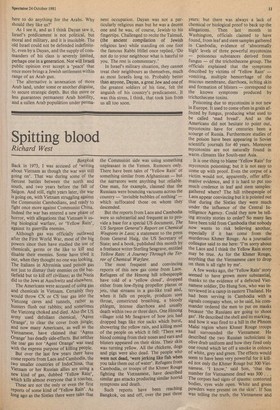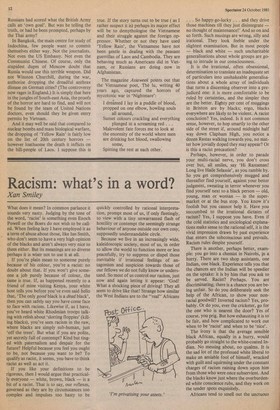Spitting blood
Richard West Bangkok Back in 1973, I was accused of 'writing about Vietnam as though the war was still going on'. That was during some of the fiercest battles between the north and south, and two years before the fall of Saigon. And still, eight years later, the war is going on, with Vietnam struggling against the Communist Cambodians, and ready to fight once more against Communist China. Indeed the war has entered a new phase of horror, with allegations that Vietnam is using biological warfare, or 'Yellow Rain', against its guerrilla enemies.
Although gas was officially outlawed after the First World War, most of the big Powers since then have studied the use of chemicals, germs or the like to kill and disable their enemies. Some have tried it out, when they thought no one was looking. The Italians in Abyssinia used poison gas not just to dismay their enemies on the battlefield but to kill off civilians; as the Nazis did to the Jews at Auschwitz and elsewhere.
The Americans were accused of using gas and chemicals in Vietnam. Certainly they would throw CX or CS tear gas into the Vietcong caves and tunnels, rather as hunters flush out rabbits; and sometimes the Vietcong choked and died. Also the US army used defoliant chemical, 'Agent Orange', to clear the cover from jungle; and now many Americans, as well as the Vietnamese, have claimed that 'Agent Orange' has deadly side-effects. But neither the tear gas nor 'Agent Orange' was used With the express purpose of killing people. But over the last few years there have come reports from Laos and Cambodia, the two smaller countries of IndoChina, that Vietnam or her Russian allies are using a new kind of gas, dubbed 'Yellow Rain', Which kills almost everyone that it touches. These are not the only or even the first reports of some kind of 'Yellow Rain'. As long ago as the Sixties there were tales that the Communist side was using something unpleasant in the Yemen. Rumours only. There have been tales of 'Yellow Rain' or something similar from Afghanistan — but the narrators were anything but reliable. One man, for example, claimed that the Russians were bouncing vacuums across the country — 'invisible bubbles of nothing' — which suffocated those on whom they descended.
But the reports from Laos and Cambodia were so substantial and frequent as to provide a base for a special US document, The US Surgeon General's Report on Chemical Weapons in Laos; a statement to the press from General Haig, the US Secretary of State; and a book, published this month by a freelance writer Sterling Seagrave, entitled Yellow Rain: A Journey Through the Terror of Chemical Warfare. The most frequent and convincing reports of this new gas come from Laos. Refugees of the Hmong hill tribespeople have told of a 'yellow cloud', dropped either from low-flying propellor planes or jets, that streams in a gas-like trail and, when it falls on people, produces sore throat, constricted breathing, a bloody phlegm, intense diarrhoea and usually death within two or three days. One Hmong villager told Mr Seagrave of how jets had dropped bags like rice sacks which burst, showering the yellow rain, and killing most of the people on which it fell: 'There was blood coming from their noses and ears and blisters appeared on their skins. Their skin was turning yellow. All the chickens, dogs and pigs were also dead. The people who were not dead, 'were jerking like fish when you take them out of water'. Refugees from Cambodia, or troops of the Khmer Rouge fighting the Vietnamese, have described similar gas attacks producing similar horrid symptoms and death. Such reports have been reaching Bangkok, on and off, over the past three years: but there was always a lack of chemical or biological proof to back up the allegations. Then last month in Washington, officials claimed to have found, from leaf and stem samples gathered in Cambodia, evidence of 'abnormally high' levels of three powerful mycotoxins — poisonous substances derived from fungus — of the trichothecene group. The officials explained that the symptoms described by victims of 'Yellow Rain' — vomiting, multiple hemorrhage of the mucous membrane, diarrhoea, itching skin and formation of blisters — correspond to the known symptoms produced by trichothecene toxins.
Poisoning due to mycotoxins is not new in Europe. It used to come often in grain affected by fungus, producing what used to be called 'mad bread'. And as the Americans did not hesitate to point out, mycotoxins have for centuries been a scourge of Russia. Furthermore studies of the poison have been appearing in Soviet scientific journals for 40 years. Moreover mycotoxins are not naturally found in warm climates like South-east Asia.
It is one thing to blame 'Yellow Rain' for mycotoxin poisoning; but it is not easy to come up with proof. Even the corpse of a victim would not, apparently, offer affirmative evidence, and it is hard to put too much credence in leaf and stem samples: gathered where? The hill tribespeople of Laos appear convincing but it is pointed out that during the Sixties they were much under the influence of the Central Intelligence Agency. Could they now be telling atrocity stories to order? So many lies have been told from Cambodia that nobody now wants to risk believing another, especially if it has come from the murderous Khmer Rouge. As a journalist colleague said to me here: 'I'm sorry about the Laos and I think the Yellow Rain story may be true. As for the Khmer Rouge, anything that the Vietnamese care to drop on them is all right by me'.
A few weeks ago, the 'Yellow Rain' story seemed to have grown more substantial, thanks to the evidence of a defected Vietnamese soldier, Do Hung Son, who was interviewed in a camp in eastern Thailand. He had been serving in Cambodia with a signals company when, so he said, his commander ordered the men to put on masks because 'the Russians are going to shoot gas'. He described the shell and its marking, and how it was fired to a hill in the Phnom Malai region where Khmer Rouge troops had surrounded the Vietnamese. He described the two Russian technicians in olive drab uniform and how they fired only one round which let off a smoke in colours of white, grey and green. The effects would seem to have been very powerful for it killed not only the Khmer Rouge but 300 Vietnamese. 'I know,' said Son, 'that the number for Vietnamese dead was 300 . . . The corpses had signs of spasms: contorted bodies, eyes wide open. White and green Powders were present on the skin'. If Son was telling the truth, the Vietnamese and Russians had scored what the British Army calls an 'own goal'. But was he telling the truth, or had he been prompted, perhaps by the Thai army?
In Bangkok, the main centre for study of Indochina, few people want to commit themselves either way. Not the journalists. Not even the US Embassy. Not even the Communist Chinese. Of course, only the stupidest dupes of Moscow doubt that Russia would use this terrible weapon. Did not Winston Churchill, during the war, authorise dropping the dreadful anthrax disease on German cities? (The controversy now rages in England.) It is simply that here in the jungles of South-east Asia, the proofs of the horror are hard to find, and will not be found by the team of United Nations doctors, even should they be given entry permits by Vietnam.
And it may well be said that compared to nuclear bombs and mass biological warfare, the dropping of 'Yellow Rain' is fairly low on the list of 20th century horrors — however loathsome the death it inflicts on the hill-people of Laos. I suppose this is true. If the story turns out to be true ( as I rather suspect it is) perhaps its major effect will be to demythologise the Vietnamese and their struggle against the foreign oppressor. Whether or not they have used 'Yellow Rain', the Vietnamese have not been gentle in dealing with the peasant guerrillas of Laos and Cambodia. They are behaving much as Americans did in Vietnam, or Russians are doing now in Afghanistan.
The magazine Asia week points out that the Vietnamese poet, The lu, writing 40 years ago, captured the horrors of mycotoxic war in 'Nightmare': I dreamed I lay in a puddle of blood, propped on one elbow, howling souls all around, Sunset colours crackling and everything plunged in a screaming red. . . Malevolent fate forces me to look at the enormity of the world where men are drinking hot blood, swallowing some, Spitting the rest at each other.



































 Previous page
Previous page